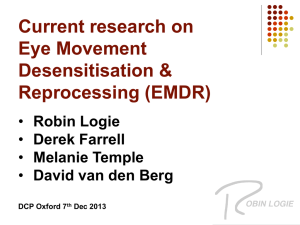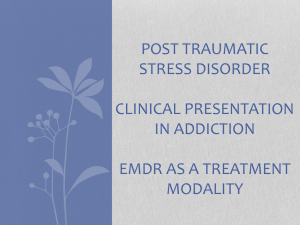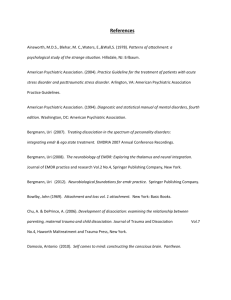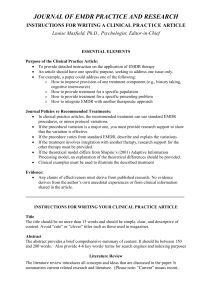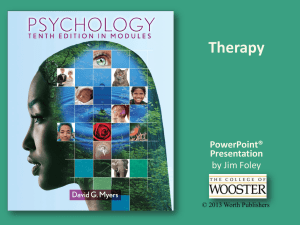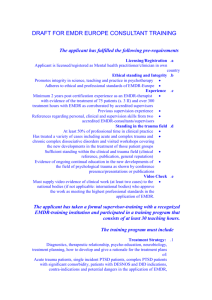REVIEW FORM For Journal of EMDR Practice and Research
advertisement
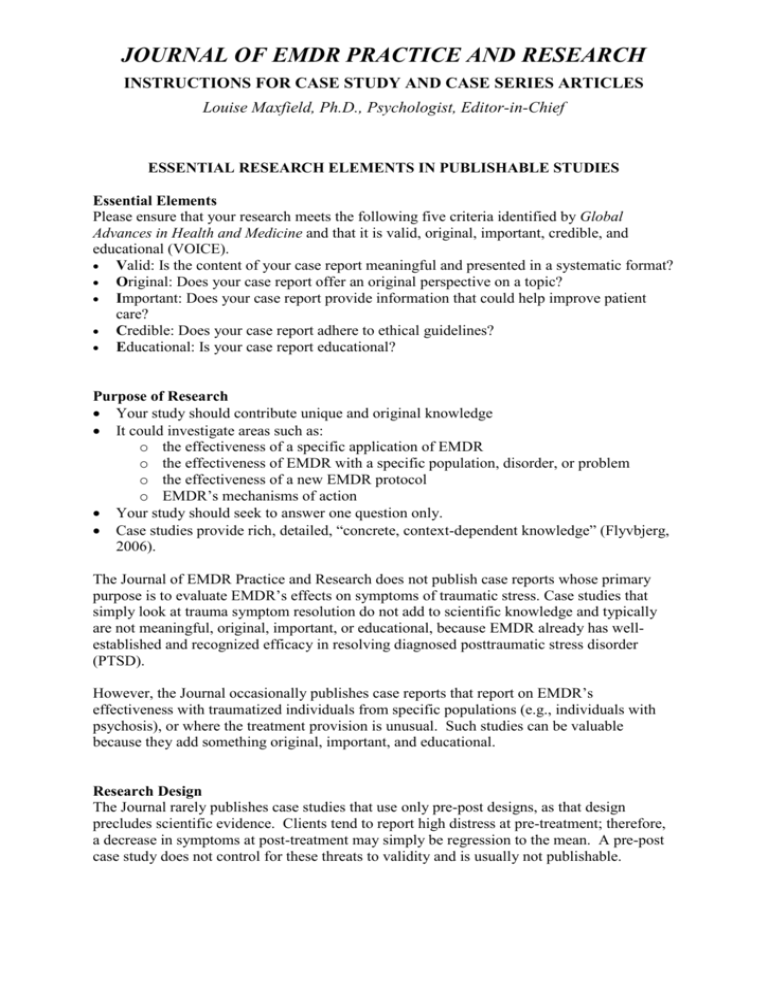
JOURNAL OF EMDR PRACTICE AND RESEARCH INSTRUCTIONS FOR CASE STUDY AND CASE SERIES ARTICLES Louise Maxfield, Ph.D., Psychologist, Editor-in-Chief ESSENTIAL RESEARCH ELEMENTS IN PUBLISHABLE STUDIES Essential Elements Please ensure that your research meets the following five criteria identified by Global Advances in Health and Medicine and that it is valid, original, important, credible, and educational (VOICE). Valid: Is the content of your case report meaningful and presented in a systematic format? Original: Does your case report offer an original perspective on a topic? Important: Does your case report provide information that could help improve patient care? Credible: Does your case report adhere to ethical guidelines? Educational: Is your case report educational? Purpose of Research Your study should contribute unique and original knowledge It could investigate areas such as: o the effectiveness of a specific application of EMDR o the effectiveness of EMDR with a specific population, disorder, or problem o the effectiveness of a new EMDR protocol o EMDR’s mechanisms of action Your study should seek to answer one question only. Case studies provide rich, detailed, “concrete, context-dependent knowledge” (Flyvbjerg, 2006). The Journal of EMDR Practice and Research does not publish case reports whose primary purpose is to evaluate EMDR’s effects on symptoms of traumatic stress. Case studies that simply look at trauma symptom resolution do not add to scientific knowledge and typically are not meaningful, original, important, or educational, because EMDR already has wellestablished and recognized efficacy in resolving diagnosed posttraumatic stress disorder (PTSD). However, the Journal occasionally publishes case reports that report on EMDR’s effectiveness with traumatized individuals from specific populations (e.g., individuals with psychosis), or where the treatment provision is unusual. Such studies can be valuable because they add something original, important, and educational. Research Design The Journal rarely publishes case studies that use only pre-post designs, as that design precludes scientific evidence. Clients tend to report high distress at pre-treatment; therefore, a decrease in symptoms at post-treatment may simply be regression to the mean. A pre-post case study does not control for these threats to validity and is usually not publishable. Instructions for Case Study Articles p. 2 A multiple baseline design is preferred, in which several baseline assessments are conducted prior to treatment. If a multiple baseline design is not used, then it is recommended that there be a comprehensive history of the symptoms. Example: “A five year history of unresolved unipolar depression, with four related hospitalizations, and three suicide attempts.” Follow-up assessments are almost always required. Measures Measures should be related to the research focus and the focus of treatment. For example, if the research focus is self-esteem and the treatment target is trauma, we would expect two different measures to track changes in each domain. Commonly used measures with known psychometric properties are strongly preferred. Behavioral and/or functional assessments are also appreciated. Behavioral measures should be those commonly used in similar case studies. For example, a case study investigating the treatment of pain should use a daily pain diary. If qualitative measures are used, use standard procedures to develop the interview. Treatment Use replicable procedures. The evaluated treatment can use standard EMDR procedures, protocol variations, or integration with another treatment. If the procedural variation is a major one, the variation or its rationale must have research support. Analysis of Results If qualitative measures are used, use standard procedures to analyse the responses. Evaluation of clinical significance is recommended. ================================================================== INSTRUCTIONS FOR WRITING YOUR RESEARCH ARTICLE Title The title should be no more than 15 words and should be simple, clear, and descriptive of content. Avoid “cute” or “clever” titles such as those used in magazines. Abstract The abstract provides a brief comprehensive summary of content, mentioning problem, participants, design, results, and conclusions. It should be between 150 and 200 words. Also provide 4-6 key words/ terms for search engines and indexing purposes Literature Review The literature review introduces your themes and shows the relevance of your hypotheses. It summarizes current related research and literature. (Please note: “Current” means recent, within the last 10 years, since 2005, except for seminal papers/books). All core concepts being discussed in the paper must be introduced here. Do not introduce new ideas in the Instructions for Case Study Articles p. 3 Discussion. It is expected that you will have about 25 references. Please ensure that all the following are included in this section and please use headings for each section of the literature review. There should be at least one heading on each manuscript page. Introduce the problem/issue Introduce your research question or the study’s purpose at the beginning of the article. Explain/define unique terms, specific language, diagnoses, etc. Describe common and current ways that problem/ issue is treated/addressed If another treatment is being integrated with EMDR, introduce that treatment and explain how it is commonly used Assume the reader of your article has no prior knowledge about EMDR. Introduce EMDR, stating that it has established efficacy for PTSD with appropriate citations. o Add a brief description of AIP model if relevant (e.g., if AIP is referred to in the Case Description/s or theoretical discussions) o Provide a brief description of EMDR therapy (enough so that a naïve uninformed reader can understand the paper), o Introduce any EMDR term or concept that is referred to in the Case Description/s (e.g., SUD, VOC, interweave, NC, PC, installation). Summarize related EMDR publications. Focus your summary on the problem area being investigated in your paper. Do not summarize EMDR research unrelated to your topic. Do not summarize theories not related to your research. For example, lengthy neurobiological explanations are only needed in neurobiological papers. Articulate your research question. Highlight research related to the hypothesis which you are investigating in this paper. Build the conceptual foundation for your study. Explain the case conceptualization which has led to your investigation If your research uses or investigates a major variation in EMDR procedures, provide research support for the modification or for its rationale. Method The Method section provides a brief comprehensive overview of the study methodology. This section provides all background information needed to understand the subsequent Case Descriptions, and allows the Case Descriptions to flow as coherent narratives. It contains the following sections. Keep content brief. Please use headings for each section as indicated. Design (or Procedures) Provide a summary of the overall design. o Example: “Participants attended three baseline assessment sessions over a period of one month. This was followed by ten weekly one hour treatment sessions, with some measures administered every two weeks before the treatment session. Post treatment assessments were conducted one week after the final session and follow-up assessments were done at three and six month periods.” Note that multiple baseline designs are recommended. See above section, “Study design”. Follow-up assessments are generally required. We rarely publish pre-post case studies. Participant/s Explain who, why, and how the participant(s) was (were) selected for this study. o Example: “Participants were three consecutive female clients, referred to the author’s practice. Each had been diagnosed with major depressive disorder by an Instructions for Case Study Articles p. 4 external assessor. The women were Caucasian, and were aged 24, 39, and 46 years. (Details follow in the Case Description sections.)” Treatment Identify the therapist and his/her qualifications, credentials, and/or experience. State if and how treatment fidelity was evaluated/ assured. Provide a summary of the investigated treatment with sufficient detail that it can be replicated by readers. o Example: “The treatment provided standard EMDR procedures with one minor modification. Consistent with the theme of this investigation, all NC’s and PC’s were focused on the clients’ fear of rejection. Interweaves also maintained this same focus.” If the theoretical model differs from Shapiro’s (2001) Adaptive Information Processing model, an explanation of the theoretical differences should be provided. Measures Provide a description of the psychometric measures, and their psychometric properties, with information about score interpretation. State your method and frequency of administration. Identify the assessor, and if relevant, his/her qualifications. It is expected that measures used in pre-treatment assessments will also be administered at post-treatment and follow-up. If this was not the case, provide an explanation. Explain all behavioral measures (e.g., log of child’s tantrums) and their administration. When describing treatment, report SUD and VOC scores as needed to clarify process. If qualitative measures were used, explain how the interview was developed and administered, and what analysis was conducted. Equipment If any special equipment was used, describe it in this section. The term “equipment” does not refer to measures and test materials. Description of Case #1 Make sure you preserve patient confidentiality and that clients cannot be identified. Appropriate informed consent must be obtained from clients prior to case study submission. Presentation Demographic information – age, gender, marital status, employment, relevant specifics Referral Presenting problem Client History History relevant to the presenting problem Past treatment Initial Assessment/s Results of initial baseline assessment If possible, provide diagnosis Use a table or figure to provide assessment results where appropriate Instructions for Case Study Articles p. 5 Case Conceptualization Explain case conceptualization and reasons for planned treatment Therapy Describe treatment provision in sufficient detail that readers can understand process Organize chronologically by sessions, or treatment phases, or targets. Use headings. If assessments are conducted during treatment, describe these to provide reader with a picture of ongoing treatment process Describe all three prongs of treatment: past, present, and future. If relevant, highlight important transition moments, perhaps providing detail such as a brief session transcript or a quote from client Identify therapist decision points If relevant, mention challenges, set-backs, reformulation of case conceptualization Explain rationale for termination (how, when, why) Post-treatment Assessment Describe outcomes on measures used for pre-treatment assessment Describe current functioning If possible, provide diagnosis Follow-up Describe outcomes on measures used for pre-treatment assessment Describe current functioning If possible, provide diagnosis Description of Case #2 (and #3, #4 …) Case description for other participants generally follows the same pattern, although occasionally authors may choose, for teaching purposes, or for clarity, to combine cases in the Case Description section Discussion The Discussion section summarizes, evaluates, interprets, and explains the treatment application. Include the following, if relevant and appropriate: Expand on concepts and ideas that were already introduced in the Literature Review Link to prior publications, research Describe the strengths and limitations of the presented material Use scientific objective language describing your results. Provide a thoughtful critical analysis of the outcome/s. Any claims for evidence arising from case study data must be framed according to standard scientific procedures. If you want to generalize from your study, explain why generalizations might be considered. (See Flyvbjerg, 2006) Discuss theoretical aspects Discuss practical consequences Explain when and how to use the recommended treatment. Explain indications and contra-indications, describing who might benefit and who should not be treated with the proposed treatment. Recommend future research with concrete ideas and practical designs to test proposed treatment. Instructions for Case Study Articles p. 6 EXAMPLES OF CASE STUDIES PUBLISHED IN JEMDR Some Single Case Examples: Bae, H., & Daeho, K. (2012). Desensitization of triggers and urge reprocessing for an adolescent with internet addiction disorder. Journal of EMDR Practice and Research, 6(2), 73-81 Grey, E. (2011). A pilot study of concentrated EMDR: A brief report. Journal of EMDR Practice and Research, 5(1), 14-24. Phillips, K. M., Freund, B., Fordiani, J., Kuhn, R., & Ironson, G. (2009). EMDR treatment of past domestic violence: A clinical vignette. Journal of EMDR Practice and Research, 3(3), 192-197 Wesson, M., & Gould, M. (2009). Intervening early with EMDR on military operations: A case study. Journal of EMDR Practice and Research, 3(2), 91-97. Some Case Series Examples: Buydens, S. L., Wilensky, M., & Hensley, B. J. (2014). Effects of the EMDR protocol for recent traumatic events on acute stress disorder: A case series. Journal of EMDR Practice and Research, 8(1), 2-12. Frustaci, A., Lanza, G. A., Fernandez, F., di Giannantonio, M., & Pozzi, G. (2010). Changes in psychological symptoms and heart rate variability during EMDR treatment: A case series of subthreshold PTSD. Journal of EMDR Practice and Research, 4(1), 3-11. Gauvreau, P., & Bouchard, S. (2008). Preliminary evidence for the efficacy of EMDR in treating generalized anxiety disorder. Journal of EMDR Practice and Research, 2(1), 26-40. Jarero, I., Artigas, L., Montero, M., & Lena, L. (2008). The EMDR integrative group treatment protocol: Application with child victims of a mass disaster. Journal of EMDR Practice and Research, 2(2), 97-105. Miller, R. (2012). Treatment of behavioral addictions utilizing the feeling-state addiction protocol: A multiple baseline study. Journal of EMDR Practice and Research, 6(4), 159-169. Ricci, R. J., & Clayton, C. A. (2008). Trauma resolution treatment as an adjunct to standard treatment for child molesters: A qualitative study. Journal of EMDR Practice and Research, 2(1), 41-50 Rost, C., Hofmann, A., & Wheeler, K. (2009). EMDR treatment of workplace trauma: A case series. Journal of EMDR Practice and Research, 3(2), 80-90. Wesselmann, D., & Potter, A. E. (2009). Change in adult attachment status following treatment with EMDR: Three case studies. Journal of EMDR Practice and Research, 3(3),178 Instructions for Case Study Articles p. 7 STYLE 1. Manuscripts must be professionally prepared in accordance with the Publication Manual of the American Psychological Association, 6th edition, 2009. http://www.apastyle.org/manual/whats-new.aspx A sample paper can be viewed at: http://flash1r.apa.org/apastyle/basics/data/resources/sample-papers.pdf 2. Page size should be “Letter” size (8.5 x 11 inches, 21.59 x 27.94 cm), with a one inch (2.54 cm) margin on all sides. 3. Font is Times Roman, size 12. Manuscripts are double-spaced, about 20-35 pages in length. Double-space everything, including references, quotations, tables, and figures. 4. Format with a left margin alignment (not justified). Each paragraph should have a first line-indent. There should be no spaces between paragraphs. 5. The first page must include authors’ names, affiliations, and full contact information (address, phone, fax, and e-mail). This information should not be included elsewhere in the manuscript, to ensure blind review. 6. The second page contains only the title of the paper, abstract, and key words. The title should be no more than 15 words. Abstracts are 150-200 words. List 4 to 6 key words/terms below the abstract. 7. The header on each page should contain the running head for the manuscript, and the page number. Number manuscript pages consecutively in the header on each page. 8. If possible, figures should be black, white, and grey scale. Photos and line art figures should be sent as tiff (300ppi) or eps (800ppi) or jpeg files. All illustrations (i.e., photographs, drawings, diagrams, and charts) should be numbered (with Arabic numerals) and referred to by number in the text (e.g., Figure 1). The captions for illustrations should be typed on a separate sheet of paper; this page and the figures should be placed after the References at the end of the manuscript. 9. Tables should be numbered (with Arabic numerals) and referred to by number in the text (e.g., Table 1). Each table should be typed on a separate sheet of paper, and placed after the References at the end of the manuscript. Center the title above the table; the title should be short. Type explanatory notes below the table. 10. References use a hanging indent and are formatted according to APA style. Instructions are accessible in many online sites. (Also, see APA sample paper in #1 above.) 11. Please use APA style headings for sections and subsections, with at least one heading per manuscript page to guide the reader and provide organization. Headings should be clear and descriptive – not the clever quotations sometimes used in book chapters. References Flyvbjerg, B. (2006). Five Misunderstandings About Case-Study Research, Qualitative Inquiry, 12 ( 2) 219-245. Available: http://arxiv.org/ftp/arxiv/papers/1304/1304.1186.pdf Global Advances in Health and Medicine (2013). Call for articles. Global Advances in Health and Medicine 2(1), 79. Available: http://www.gahmj.com/doi/full/10.7453/gahmj.2013.2.1.012
